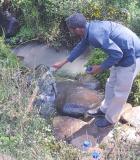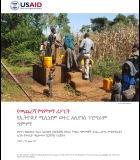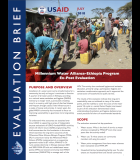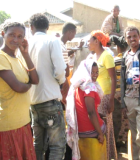Ethiopia Millennium Water Alliance (MWA-EP)
Despite of decades of efforts to improve water, sanitation, and hygiene (WASH) in Ethiopia, its key WASH indicators remain some of the lowest in the world. As of 2015, only 30 percent of the rural Ethiopian population had access to water that meets its basic needs; 4 percent used improved, nonshared sanitation; and 99 percent lacked any handwashing facility. With well over 14,000 children under 5 dying from diarrheal disease annually in Ethiopia, it is imperative that WASH development activities are effective, efficient, and have long-lasting impacts. As in other sub-Saharan African countries, sustainability has been a challenge in Ethiopia. For example, a 2010/2011 national WASH inventory rated 25 percent of water points as non-functional.This reflects growing, though limited, evidence across the sector of high rates of water point failure, sometimes just a few years after construction.The consequences are wasted money and time, disappointed communities, and dangerous health conditions.
Activity Description
In 2002, only 12 percent of Ethiopia’s rural population had access to an improved water source, and seven percent had access to adequate sanitation facilities.12 Water and sanitation-related diseases, particularly diarrhea, are the number two cause of death in Ethiopia followed by malaria and HIV/AIDS.13 Schools suffered from a lack of basic sanitation, and girls were frequently absent due to a lack of sanitation or due to household (HH) chores related to fetching water at a great distance from their homes. According to the MWA-EP’s baseline survey, completed in 2006, 76 percent of families inintervention areas had no access to an improved water source for daily household consumption. Women and girls were spending on average 57 minutes per day collecting water for their HHs.
To address this situation, MWA implemented MWA-EP in 24 rural woredas (districts) in Ethiopia between March 2004 and December 2009 with a total budget of approximately $7 million, including $4,677,670 from USAID and $2,382,972 from MWA cost-share. A consortium comprised of eight MWA IPs implemented the activity—CARE, Catholic Relief Services (CRS), Food for the Hungry (FH), Lifewater International (LI), Living Water International (LWI), Water Partners International (subsequently renamed Water.org), Hope 2020, and World Vision (WV)—along with local subcontracting non-governmental organizations (NGOs) Relief Society of Tigray (REST), Ethiopian Kale Hiwot Church (EKHC), Water Action, and Ethiopian Evangelical Church Mekane Yesus-Development and Social Services Commission (EECMY-DASSC). Though funding varied by IP both in total amount and duration, on average, each IP received approximately $900,000 in funding.






